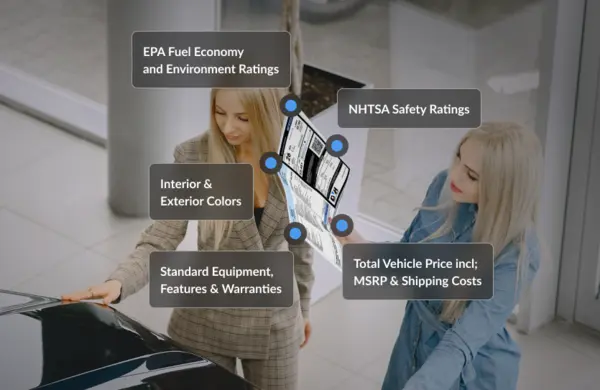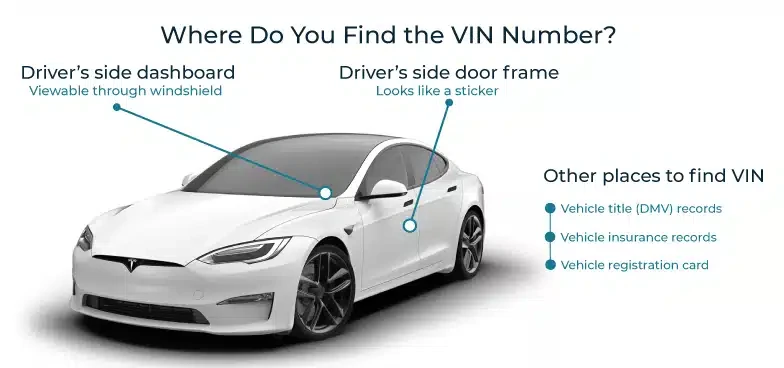Beste Bewertung Bericht zur Fahrzeughistorie
Holen Sie sich einen Bericht über die Historie von Autos, Motorrädern, Lastwagen und sogar Oldtimern. Greifen Sie auf Unfallhistorie, Titelmarken, Diebstahlaufzeichnungen, Verkaufsgeschichte, offene Rückrufe und mehr zu.
Möchten Sie mehr über die Merkmale, Optionen und Pakete der Fahrzeuge erfahren? Fensteraufkleber Lookup
Was ist ein Bericht zur Fahrzeughistorie?
Hvad er en køretøjshistorikrapport?
Hvad er de almindelige risici ved køb af en brugt bil?
Køb af brugte biler er altid forbundet med en risiko, især hvis sælgeren ikke oplyser om bilens reelle tilstand og historie. Nogle almindelige risici er:
Versteckte Schäden
Ein Fahrzeug könnte einen schweren Unfall oder eine Überschwemmung erlitten haben, die schwere Schäden oder Korrosion hinterlassen haben. Ohne eine vollständige Überprüfung der Historie bleiben solche Schäden oft unentdeckt.
Mechanische Probleme
Einige Fahrzeuge werden mit Motor-, Getriebe- und Elektrikproblemen zum Verkauf angeboten, die nicht leicht zu erkennen sind und zu kostspieligen Reparaturen führen können.
Betrug mit Titeln und Markentiteln
Verkäufer können einen markenrechtlich geschützten Titel "waschen" oder verbergen (Bergungsfahrzeug, umgebautes Fahrzeug, Schrottfahrzeug). So kann sich beispielsweise herausstellen, dass ein Auto mit "sauberem" Titel anderswo als Totalschaden deklariert wurde.
Kilometergeld-Betrug
Einige Verkäufer verändern den Kilometerstand auf betrügerische Weise, um den Anschein zu erwecken, dass das Fahrzeug weniger abgenutzt ist, als es tatsächlich ist. Mehr als 450.000 Fahrzeuge pro Jahr haben zurückgesetzte Kilometerzähler.
Ausstehende Kredite oder sogar gestohlen
Das Fahrzeug kann unbezahlte Kredite haben und sogar gestohlen sein, so dass der Kreditgeber oder die Polizei es nach dem Kauf jederzeit zurückfordern kann.
Unangekündigte Rückrufe
Bei einigen Gebrauchtwagen gibt es offene Sicherheitsrückrufe, die noch nicht behoben wurden, was ernsthafte Risiken birgt. Die Verkäufer erwähnen sie möglicherweise nur auf Nachfrage.
Get the Full Car Report About Any Car Before You Buy or Sell
Viele Autokäufer übersehen Schäden, Unfälle, Überschwemmungsschäden, Bergungsschäden, Diebstahlberichte und vieles mehr. Am Ende sind sie nicht in der Lage, den wahren Zustand eines Fahrzeugs zu überprüfen. Mit unseren umfassenden Fahrzeughistorienberichten bleiben sie geschützt und können die richtigen Entscheidungen treffen.
Für Einkäufer
- Versteckte Schäden vor dem Kauf erkennen
- Überprüfung der Eigentumsverhältnisse und Aufspüren gestohlener Unterlagen
- Vergewissern Sie sich, dass ein Fahrzeug ordnungsgemäß gewartet wurde
- Bessere Verhandlungen führen und mehr Wert erzielen
- Erkennen Sie Betrug und lassen Sie die Finger von riskanten Geschäften
- Vermeiden Sie kostspielige Reparaturen nach dem Kauf

Für Verkäufer
- Seien Sie transparent in Bezug auf frühere Aufzeichnungen und erzielen Sie schnellere Verkäufe.
- Autos mit historischen Berichten können für bis zu 15% mehr verkauft werden.
- Rechtfertigen Sie den Preis eines Autos mit einer genauen Fahrzeughistorie.
- Die Bereitstellung eines Fensteraufklebers (Werksoptionen und UVP) schafft Vertrauen beim Käufer.
- Erleichtern Sie Autokäufern den Vergleich mehrerer Fahrzeuge.
- Überprüfen Sie den Wert und den Zustand eines Fahrzeugs, bevor Sie es in Zahlung geben.

What Will You Get in Our Vehicle Report?
Ein Bericht über die Fahrzeughistorie zeigt alles auf, was in der Lebenszeit eines Fahrzeugs passiert ist, einschließlich Titelaufzeichnungen, Unfälle, Kilometerstände, Eigentumsaufzeichnungen, Diebstähle, Wartungsaufzeichnungen und mehr. Hier ist, was Sie in einem Fahrzeughistorienbericht finden können:
Titelprüfung Aufzeichnungen
Wissen Sie, ob das Fahrzeug einen Markentitel hat? Mit unserer VIN-Check-Tool, können Sie für Schrott, rebuilt, Schrott, Hochwasserschäden, Feuer Marke, Zitronen, Hochwasser Marke, und alle anderen Titel gebrandmarkt zu überprüfen.
Aufzeichnungen über Unfälle und Beschädigungen
Fragen Sie sich, ob das Auto einen Unfall hatte oder im Laufe seines Lebens Schäden gemeldet wurden? Sehen Sie alle Unfallberichte und die Schwere der Schäden mit einem detaillierten Bericht über die Fahrzeughistorie.
Kilometerzählerstände
Mit einem detaillierten Bericht zur Fahrzeughistorie können Sie den Kilometerstand auf dem Tacho zu verschiedenen Zeitpunkten überprüfen und feststellen, ob er vor dem Verkauf manipuliert wurde.
Aufzeichnungen über das Eigentum
Privates Auto? Taxi? Mietwagen? Mehrere Besitzer? Informieren Sie sich über die Nutzungsgeschichte Ihres Fahrzeugs sowie über die Anzahl der Vorbesitzer, den Standort der Besitzer und die Dauer des Besitzes.
Rückrufe
Informieren Sie sich über Rückrufaktionen des Herstellers oder der NHTSA und stellen Sie sicher, dass ein Fahrzeug in verkehrssicherem Zustand ist oder nicht.
Gestohlene Aufzeichnungen
Wissen Sie, ob ein Fahrzeug als gestohlen gemeldet ist? Ein Bericht zeigt, ob ein Fahrzeug in der Vergangenheit gestohlen wurde und ob es wiedergefunden wurde. Vermeiden Sie eine Strafanzeige und den Verlust Ihres Autos und Geldes.
Service- und Wartungsaufzeichnungen
Prüfen Sie, ob der Gebrauchtwagen in der Vergangenheit ordnungsgemäß gewartet und gepflegt wurde. Vergewissern Sie sich vor der Bezahlung, dass es in einem guten Zustand ist.
Pfandrecht und Darlehensaufzeichnungen
Überprüfen Sie, ob das Fahrzeug, an dem Sie interessiert sind, keine Pfandrechte oder Kreditaufzeichnungen hat, die Sie nach dem Kauf eines Fahrzeugs, an dem Sie interessiert sind, beeinträchtigen könnten.
Auktions- und Verkaufsgeschichte mit Fotos
Unser Bericht zur Fahrzeughistorie zeigt, ob ein Auto auf Auktionen verkauft wurde und in welchem Zustand es sich befindet (mit Fotos). Sie können auch die vollständige Verkaufshistorie sehen - wann, wo, wie oft und zu welchem Preis es angeboten wurde - und, falls verfügbar, auch Bilder.
Erhalten Sie mehr als nur Geschichtsberichte!
Wir bieten mehr als nur Berichte zur Fahrzeughistorie! Mit unserer Suite von Tools können Autokäufer und -verkäufer leicht alles erfahren, was sie über jedes Fahrzeug wissen müssen, und fundierte Entscheidungen treffen:
Original-Fensteraufkleber nach VIN
Rufen Sie sofort den Fensteraufkleber des Fahrzeugs nach VIN auf und sehen Sie den Original-MSRP, die Farbe, die Standardausstattung, die Optionen, den Kraftstoffverbrauch, die Garantie und vieles mehr.
Baupläne für klassische Fahrzeuge
Mit unserem Build Sheet Lookup Tool für klassische Fahrzeuge können Sie Build Sheets nach VIN für klassische oder historische Fahrzeuge abrufen. Sehen Sie sich die technischen Daten, Merkmale, Farbe, Preise und mehr an.
The Benefits of Using Our Vehicle History Lookup
Die Verwendung von detaillierten Fahrzeughistorienberichten gibt Ihnen die volle Kontrolle über den Gebrauchtwagenkauf oder -verkauf und eine bessere Verhandlungsposition. Hier ist, was Sie mit unseren Berichten erwarten können:
Vermeiden Sie kostspielige Überraschungen
Informieren Sie sich mit unseren Daten im Voraus über frühere Unfälle, Markenzeichen oder Hochwasserschäden. Das kann Ihnen Tausende von Reparaturen ersparen. Ein Nutzer bemerkte fehlende Carfax-Informationen, die wir gefunden haben.
Besser verhandeln
Nutzen Sie die Details des Berichts, um einen niedrigeren Preis auszuhandeln oder Ihr Angebot zu rechtfertigen. (Verkäufer nutzen unsere Berichte sogar, um höhere Preise zu rechtfertigen, wenn ihre Autos sauber sind).
Schützen Sie sich selbst
Vermeiden Sie rechtliche Probleme durch Betrug oder nicht angegebene Schäden. Ein Fahrzeughistorienbericht ist bei den meisten Transaktionen ein anerkannter Nachweis für die wahre Geschichte eines Fahrzeugs.
Klügere Investitionen tätigen
Erkennen Sie risikoreiche Fahrzeuge vor dem Kauf und investieren Sie in Fahrzeuge, die ihren Wert lange erhalten. Unsere Berichte zur Fahrzeughistorie helfen Ihnen, zuverlässige Fahrzeuge zu identifizieren.
Get Your History Report by VIN in 3 Easy Steps!
Eine Fahrzeugbericht nach VIN ist ein Kinderspiel! Geben Sie einfach die Fahrgestellnummer (VIN) ein, um Fakten zum Fahrzeug, einschließlich der Unfallhistorie und mehr, abzurufen.
Schritt 1: Geben Sie Ihre VIN ein
Geben Sie die Fahrgestellnummer ein, um den Vorgang zu beginnen, oder suchen Sie nach dem US-Kennzeichen.
Schritt 2: Absenden des Formulars
Klicken Sie auf "VIN suchen", um das Formular abzuschicken und Ihre Sofortsuche zu starten.
Schritt 3: Erhalten Sie Ihren Bericht
Tätigen Sie die erforderliche Zahlung, um einen detaillierten und leicht zu lesenden Bericht über den Fahrzeugverlauf zu erhalten.
Das war's! Keine Anrufe oder Papierkram. Wir geben Ihnen alle Fahrzeuginformationen, die Sie benötigen, mit nur wenigen Klicks.
Warum wir die beste Wahl sind: Ein Vergleich mit Wettbewerbern
Unsere Berichte zur Fahrzeughistorie sind der Konkurrenz weit voraus. Erhalten Sie mehr Informationen über JEDES Fahrzeug aus JEDEM Land, komplett mit Auktions- und Verkaufsfotos - und das zu einem Bruchteil der Kosten anderer.
Unschlagbare Preise
Wir bieten die niedrigsten Preise in der Branche! Während Carfax und AutoCheck ein Vermögen verlangen, halten wir Geschichtsberichte 100% erschwinglich.
Exklusive Verkaufsdaten
Finden Sie die Autohistorie und sehen Sie sich über 70 Millionen einzigartige Verkaufsdaten an - Daten, die Sie sonst nirgendwo finden. Treffen Sie fundierte Entscheidungen mit Vertrauen!
Weltweite VIN-Abdeckung
Unser Tool zur Abfrage der Fahrzeughistorie deckt VINs aus der ganzen Welt ab und ermöglicht Ihnen den Zugang zu Fahrzeughistorien, die andere Wettbewerber nicht bieten können.
Auktionsprotokolle, die alles enthüllen
Wenn ein Fahrzeug eine Auktion durchlaufen hat, haben wir die Details! Von den Verkaufspreisen bis zu Schäden und bis zu 10 Fotos - wir bieten Ihnen die Insiderinformationen, die Sie brauchen.
|
Merkmal
Preis
|
Carfax
$44.99
|
DVH
$19.99
|
Autocheck
$29.99
|
|---|---|---|---|
| Verkaufsliste mit Fotos | |||
| Auktionsberichte mit Fotos | |||
| Daten zum Marktwert | |||
| Detaillierte Fahrzeugdaten | Begrenzt | Begrenzt | |
| Fensteraufkleber | |||
| Unterstützung für klassische Fahrzeuge | |||
| Empfehlung zur Wartung | |||
| Geschichte der Eigentümerschaft | |||
| Unfallgeschichte | |||
| Prüfung der Beschädigung | |||
| Prüfung des Markentitels | |||
| Prüfung des Bergungsanspruchs | |||
| Karte der Eigentumsverhältnisse | |||
| Rückrufe | |||
| Halterungen für schwere Lastwagen, ATVs, Anhänger und Motorräder | |||
| Mobile und Desktop-Anwendungen | Begrenzt |
Lookup History Report for All Vehicle Types
Wir bieten Berichte für alle Fahrzeugtypen an, von Fahrzeugen, die nach 1981 hergestellt wurden, bis hin zu Oldtimer-Historienprüfungen, und erstellen detaillierte Berichte für Motorräder, Lastwagen, Anhänger, Wohnmobile und mehr.
Klassische Autos
Musterbericht anzeigenDieser Oldtimer hat einen Markentitel, einen Unfall, zwei Schadensberichte und zwei Auktionsberichte.
Motorräder
Musterbericht anzeigenDieses Motorrad hat einen Markentitel, einen abweichenden Kilometerstand, einen Unfall mit Schäden, zwei Pfandrechte oder Darlehensaufzeichnungen, vier Ereignisberichte und wurde zuvor online zum Verkauf angeboten.
Dieses ATV hat einen Markeneintrag, Schadenseinträge, Auktionseinträge, Verkaufseinträge und zwei Pfandrechte oder Darlehenseinträge.
Schwere Lastkraftwagen
Musterbericht anzeigenDieser Lkw hat einen Markentitel, einen Unfall mit Beschädigung, 13 offene Rückrufe, zwei Pfandrechte oder Kreditaufzeichnungen, zwei Ereignisberichte und eine Auktionsaufzeichnung.
Dieses Wohnmobil hat einen Markentitel, einen Schadensbericht, einen Pfand- oder Darlehensbericht, zwei Ereignisberichte und einen Auktionsbericht.
Anhänger
Musterbericht anzeigenDieser Anhänger hat einen Markentitel, drei Unfälle, zwei Schadensprotokolle, ein Pfandrecht oder Kreditprotokoll und einen Ereignisbericht.
Vermeiden Sie kostspielige Fehler - Holen Sie sich Ihren Fahrzeughistorienbericht Jetzt!
Fahren Sie nicht mit der Frage los, was unter der Haube steckt. Mit einem Bericht zur Fahrzeughistorie kennen Sie die Geschichte eines Fahrzeugs, bevor Sie sich festlegen. Starten Sie jetzt Ihren Fahrzeug-Hintergrundcheck und kaufen Sie mit Vertrauen.
Lookup Car History Report from Popular Manufacturers
Lookup Vehicle History Report from Popular Countries
Lookup Window Sticker from Popular Manufacturers
Lookup Motorcycle History Report from Popular Manufacturers
Lookup Build Sheet from Popular Manufacturers
Lookup license plate in any U.S. state
Aktuelles aus unserem Blog
Bleiben Sie auf dem Laufenden mit den neuesten Leitfäden, Tipps und Nachrichten über Fahrzeugbesitz, sicheres Kaufen und Verkaufen und die Fahrzeuggeschichte.

Wie man die Autohistorie online überprüft
Die Geschichte eines Gebrauchtwagens zu kennen ist unbezahlbar und hilft zu wissen, ob sich die Investition in einen bestimmten Gebrauchtwagen lohnt.
Mehr lesen '
So entschlüsseln Sie eine 13-stellige VIN
In diesem Artikel zeigen wir Ihnen, wie Sie eine 13-stellige VIN mit Hilfe unseres 13-stelligen VIN-Decoders entschlüsseln können.
Mehr lesen '
Vollständige Liste der Ländercodes der VIN-Nummern
VINs identifizieren Fahrzeuge weltweit, einschließlich Herkunftsort, Werk und fahrzeugspezifischer Herstellungsdetails.
Mehr lesen 'FAQ zum Fahrzeughistorienbericht
A VIN or Vehicle Identification Number is a 17-digit number used to identify a vehicle. The VIN has detailed information about the vehicle, including the manufacturer, country of origin, model year, and other features.










